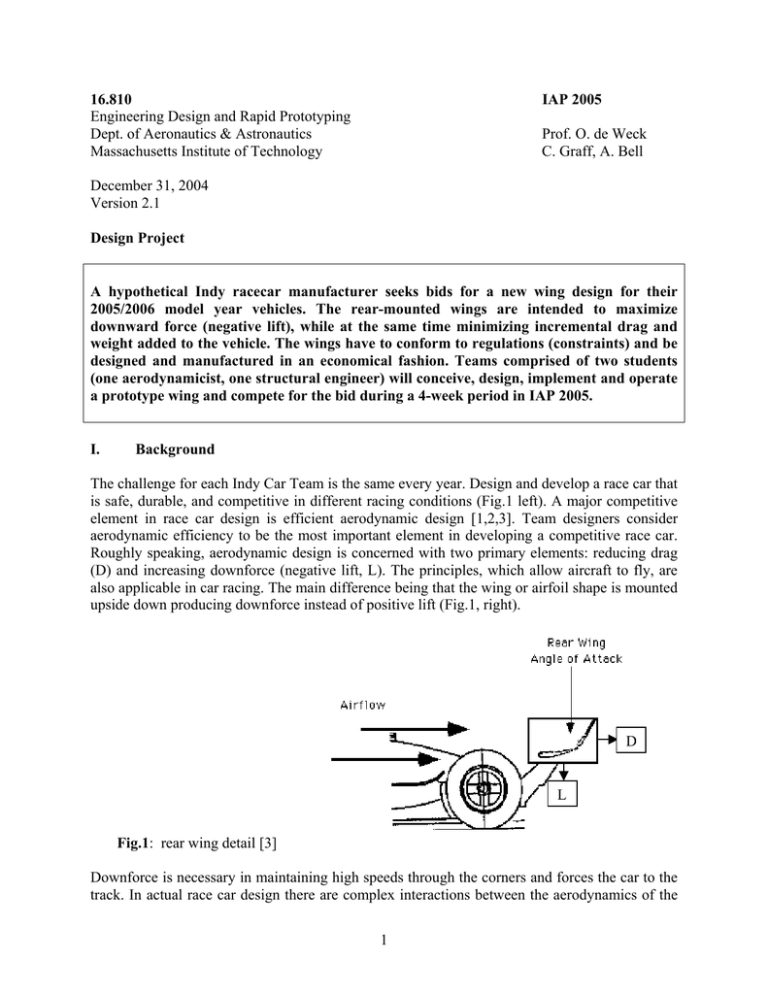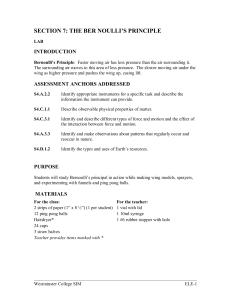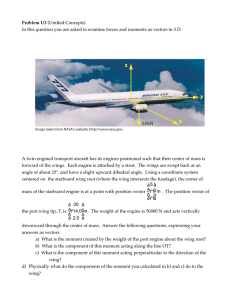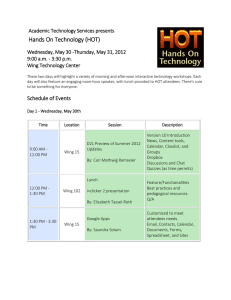16.810 IAP 2005 Engineering Design and Rapid Prototyping
advertisement

16.810 Engineering Design and Rapid Prototyping Dept. of Aeronautics & Astronautics Massachusetts Institute of Technology IAP 2005 Prof. O. de Weck C. Graff, A. Bell December 31, 2004 Version 2.1 Design Project A hypothetical Indy racecar manufacturer seeks bids for a new wing design for their 2005/2006 model year vehicles. The rear-mounted wings are intended to maximize downward force (negative lift), while at the same time minimizing incremental drag and weight added to the vehicle. The wings have to conform to regulations (constraints) and be designed and manufactured in an economical fashion. Teams comprised of two students (one aerodynamicist, one structural engineer) will conceive, design, implement and operate a prototype wing and compete for the bid during a 4-week period in IAP 2005. I. Background The challenge for each Indy Car Team is the same every year. Design and develop a race car that is safe, durable, and competitive in different racing conditions (Fig.1 left). A major competitive element in race car design is efficient aerodynamic design [1,2,3]. Team designers consider aerodynamic efficiency to be the most important element in developing a competitive race car. Roughly speaking, aerodynamic design is concerned with two primary elements: reducing drag (D) and increasing downforce (negative lift, L). The principles, which allow aircraft to fly, are also applicable in car racing. The main difference being that the wing or airfoil shape is mounted upside down producing downforce instead of positive lift (Fig.1, right). D L Fig.1: rear wing detail [3] Downforce is necessary in maintaining high speeds through the corners and forces the car to the track. In actual race car design there are complex interactions between the aerodynamics of the 1 front wing, rear wing and the main chassis as all three main components (in addition to the tires) contribute to both drag and downforce. In this project we will focus on the isolated design of one component of the race car: the rear wing. II. Project Description The project for IAP 2005 is for the students to design and build a wing section, its supports, and then test the wing in the wind tunnel. The students will be given some boundary conditions and a nominal operating condition. The main focus is on carrying out an end-to-end conceivedesign-implement-operate (CDIO) process and to learn from that experience. The maximum design envelope for the wing and its support structure is 20” x 20” x 40” (width, height, span). The wing model can be created as an extrusion of a 2D wing section, thus limiting the aerodynamic analysis to 2D section airfoils. There will be no taper or dihedral, thus simplifying the analysis further and allowing for easier manufacturing. However, taper or dihedral are not explicitly forbidden in the final design. The design task also includes developing an attachment method of the wing to the supports and load cell. The support fixture attachment points to the wing strut are pre-defined. This will allow quickly mounting and comparing wing designs produced by different teams. An example wing support strut is drawn below (Fig.2); a drawing such as this will be due as a deliverable. Fig. 2: Sample wing mounting structure (CAD drawing) 2 Dimensions: There are two support brackets located 39.75 (+/-0.5) inches apart, from inside surface to inside surface. The two bolts holes (5/16th O.D.) on each end of side the supporting fixture are 16.0 inches apart, and 1.0 inch above the lower plane of the design envelope. The support fixture is shown in the 3D view below (Fig.3). This support structure will interface with the hypothetical race car and the wind tunnel load cell. Fig. 3: Wing lower support structure and attachment points These brackets are the boundary conditions for the support struts, which the student teams will design. The design of the support strut to the wing is left open to the student design teams. The material available for students for the support struts/structure is either: A. 24 x 24 inch Aluminum 6061 plate, 0.125 inches thick B. 24 x 24 inch Aluminum 6061 plate, 0.25 inches thick. Note that the 0.25 inch thick Aluminum plate is roughly 3 times as expensive as the 6061 plate, and this will have to be taken account for in the student’s manufacturing reports and cost estimations. Wing/Strut Interface: The attachment of the wing(s) to the support structure can be done via epoxy. The wing might also need to be fiberglassed for strength. Another option is to include a supporting spar (a hollow aluminum rod, inside the wing). This option would involve cutting through the wing, span wise, to incorporate a hollow aluminum rod for support. This is an option students may have in case fiberglass is not available or desired, but note that there will be a penalty involved in costs associated with time to cut the wing and complete the assembly. Students will need to make an informed design decision with regards to fiberglassing, using a support rod or other innovative interface method. The 3D view below (Figure 4) is an example of a completed wing assembly that students will be fitting to the test fixture. A similar 3D model for the wing and support structure will also be due 3 as a deliverable. The example below is not meant to limit designer’s imagination, but provides a rough idea of what the completed product might look like. Note that the design shown in Figure 4 has not been optimized or refined, but that it will be entered as the official (staff) contribution in the design competition. Fig.4: Isometric view of 3D CAD model – baseline rear wing design III. Competition Objective Function and Constraints The hypothetical race car manufacturer will compare all bids entered into the design competition. The winner of the competition will maximize the following objective function: Objective Function: max F = L − 3 ⋅ D − 5 ⋅ W Where L = measured downforce (negative lift) at speed vo [N] D = measured drag at speed vo [N] W = total weight of the assembly (w/o support structure shown in Fig. 3) [N] The nominal speed is vo = 60 [mph]. Any change from this nominal condition will be announced within the first week of IAP. The actual objective function value for each team will be determined during wind tunnel tests during the last week of IAP. 4 All designs have to conform to the following constraints: Constraints: 1. All wing assembly designs must entirely fit in the 20” x 20” x 40” (width x height x span) design envelope specified in Section II of this document. 2. No external energy source is allowed as part of the device. 3. The interface of the assembly must conform to the hole locations and diameters specified in Figure 3. 4. The core of the wing must be built from blue insulation foam as provided by the staff. 5. The attachment structure must be built from either 24 x 24 inch Aluminum 6061 plate, 0.125 inches thick or 24 x 24 inch Aluminum 6061 plate, 0.25 inches thick. 6. Attachments between wing(s) and structure must be made with epoxy (glue) or miscellaneous attachment hardware currently available in the AA machine shop. Cost Estimate: All final designs must be accompanied by a cost estimate, which includes an estimate of both labor (hours worked) as well as material costs. A standard form will be provided separately (see also Section VI). Safety: Aside from attempting to optimize the objective function, student teams will investigate the performance of the wing over the entire wind speed range up to vo, look into the center span deflection, mass of wing, mass of support structure and natural frequency of vibration of the wing and so forth. Each wing assembly must pass a static load test and safety inspection before the assembly can be entered in the competition. There will be the option to fiberglass the outside of the foam wing to increase its stiffness and strength if deemed necessary. Design variables: Despite the constraints stated above the design space is relatively open. It can be characterized by looking at various design variables and configurations. The various lectures, interactions with faculty and staff and team interactions will help each team to focus or expand this list as appropriate: • • • • • • • • • • Aspect ratio, Wingspan, Wing chord Angle of attack Airfoil shape Camber Number of airfoil/sections Number of support struts Location of support struts Winglet (end plate) geometry and attachment Wing coating Wing/structure interface 5 Ultimately, we expect those teams to be most successful who can find interesting configurations and appropriate settings of design variables that will maximize the objective function, while ensuring robustness of the overall assembly and minimization of manufacturing costs. IV. Team Responsibilities The students will be in groups of two per design team. We expect that one student’s responsibilities will include that of an aerodynamics engineer, while the other will be that of a structural engineer. Both engineers will work together during the entire design process to ensure proper integration and function of the assembly: The aero engineer’s responsibilities include: 1. Developing a family of wing sections to meet the desired performance criteria 2. Predicting the aerodynamic loads at the wing supports 3. Predicting the performance of the wing over the desired operating range 4. Manufacturing the wing, costing the wing The structural engineer’s responsibilities include: 1. Developing a method of attaching the wing to the support brackets 2. Predicting the deflection of the wing, and natural frequency, and the maximum load. Suggesting manufacturing techniques. 3. Predicting the performance of the support structure. 4. Manufacturing the support structure, costing the structure. 5. Ensuring interface compatibility Both team members together are responsible for the quality and timeliness of the deliverables. V. Software, Resources, Experience/Knowledge The required software, resources, and previous knowledge/skill set are outlined below for each step of the design process: Design Step Hand Sketching Software/Hardware 1. Pens, pencils, stencils, other hand sketching tools 1 Location/Skills 1. Design room CAD 1. 2. 3. 4. 1. 2. 3. 4. 1. SW tutorial 2. Assume some have XFoil experience from Unified, but not all. 1. Cosmos Tutorial 2. FEA Lecture 3. CFD Lecture CAE 1 XFoil/Profili Solidworks Design room Computing resources XFoil/Profili CosmosWorks Design room Computing resources Pencils and paper will be provided during the first session. 6 CAM 1. Foam Cutter – interface with XFoil (format TBD) 2. OMAX – interface with SW (same as IAP 2004) 3. Design room 4. Computing resources Testing 1. Wind tunnel 2. Instrumentation/Calibration (6-axis load cell) 3. Data logger (EXCEL) 1. Attempt optimization of control points defining wing section geometry using Matlab and then analyzing using XFOIL (time permitting) 2. Structural optimization will be done using FEA software. Design Optimization 1. Foam cutter room – Gelb Lab, scheduling time. Materials (Foam) 2. Waterjet – Gelb Lab, Materials (Aluminum plate) 3. Fiberglass – Gelb Lab space 4. Tutorial on how to fiberglass on demand Materials (weave, epoxy, etc.) 1. Wind tunnel, scheduling time, technical assistance (Dick Perdichizzi.) 1. Matlab programming experience 2. MDO or other optimization programming (time permitting) XFoil/Profili is available from: Website: http://raphael.mit.edu/xfoil/ File Format: plain text (.dat) file. VI. Cost Estimation Each team will have to provide a completed cost estimate at the time of the CDR. 1. 2. Waterjet – the manufacturing of the aluminum support struts can be modeled using the same OMAX time/quality model used in IAP 2004. a. Use $55/hour labor rate to cost the labor of cutting out the parts on the waterjet. b. Use a $75/hour rate for use of the Waterjet OMAX machine (overhead) itself. c. The OMAX software provides an estimate of actual manufacturing cost on the screen after completion of each operation. Foam cutter – the manufacturing cost of cutting the foam core for the air-foil can be modeled as a function of time. That is due to the fact that the foam cutter operates using electric power, and thus costs the user $0.07 per watt-hour of use. 7 3. 4. 5. 6. a. Use $40/hour labor rate to cost the labor of cutting out the foam wings. Assume this charge includes overhead involved in acquiring foam and other machine use. b. The foam cutter operates at 1560 watts (13 amps), when in use. The electric company charges $70 per kilowatt-hour. Include electricity costs in your cost model. Fiberglass – the manufacturing of adding fiberglass to the wing sections can be modeled based on typical labor rates, as this requires a skilled worker. Students will be asked to estimate the time it would take a skilled worker to fiberglass a wing section, and introduce that into the final cost model. a. The labor rate for fiberglass, epoxying, and other miscellaneous labor will be $35/hour Material costs – Material costs for the aluminum, foam, and fiberglass can be modeled as functions of weight, and cuts involved. a. The sheet Aluminum costs are $50 for the 1/8” thick sheet, and $125 for the ¼” thick sheet. b. The cost for the Aluminum rod is $5 per 4-ft length. Design Work a. Assume a $75/hour labor rate for each designer b. Assume a $40/hour labor rate for use of a CAD/CAE/CAM workstation Assembly and Wind Tunnel Testing a. Assume a $55/hour labor rate for assembly work b. Assume a $300/hour cost for use of the Wright Brothers Wind Tunnel (incl. Operator) A separate cost estimation form will be provided. VII. Other Considerations 1. The critical design review will focus not only on the final results (performance and cost) of your product, but also on how this product would be integrated into the race car as a whole. This would illustrate other factors involved in designing a wing, and the relationship between other parts/subassemblies of a car. 2. Specify strength. Use a maximum deflection limit, or a safety factor for stress. This will require characterization of the foam used for the wing section cores. Our top priority is your safety. 3. Project Design Loop. Below is a diagram illustrating the “spiral development” of the example project design loop (Fig. 5). During the CDR, we will question you not only on the final outcome, but also on the design process you followed. 8 Example Project Design Loops Aero Considerations Analysis, Optimization & Iteration Structural Considerations Initial Design Manufacture Test Fig.5: Aero-Structural Design Loop References: [1] URL: http://wings.avkids.com/Book/Sports , accessed December 31, 2004 [2] Katz, Joseph, “Race Car Aerodynamics: Designing for Speed (Engineering and Performance)”, Bentley Publishers, Cambridge, MA, ISBN 0-8376-0142-8 [3] URL: http://www.nas.nasa.gov/About/Education/Racecar/aerodynamics.html 9




